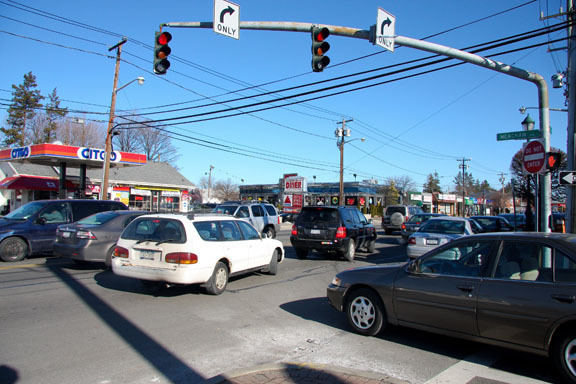Cross at your own risk
Hempstead Turnpike named most dangerous road in tri-state area
With 13 pedestrian fatalities in three years, Hempstead Turnpike was named the most dangerous road in the tri-state area in a study released last week.
The study, conducted by the Tri-State Transportation Campaign, a group that compiles Department of Transportation statistics to illuminate patterns of traffic and safety, also revealed that the bulk of the Hempstead Turnpike fatalities occurred on the stretch through Franklin Square and the Town of Hempstead.
Long Island had four of the 16 roads listed as the area’s most dangerous, many of which were state routes designed to funnel high volumes of traffic quickly through communities. The second-ranked Sunrise Highway in Suffolk County had 11 fatalities. Overall, more than 80 people were killed on Long Island roads during the three-year period the organization examined. The numbers did not include any pedestrian fatalities along the turnpike in 2009.
The study concluded that Long Island, with its combination of busy, car-centric state routes and retail-heavy towns, was a magnet for pedestrian troubles. “It’s upsetting that roads on Long Island have more pedestrian fatalities than roads in dense urban areas, where people tend to walk much more,” said Ryan Lynch, a senior planner for the Transportation Campaign who focused much of his attention on Long Island roadways.
Kate Slevin, one of the organization’s executive directors, said there were several ways the state could improve safety on Hempstead Turnpike, starting with common-sense steps like reducing the speed limit and changing the timing of stop lights along the road. Retiming the lights to give residents — especially senior citizens and people with children — more time to cross the street at crosswalks would make a huge difference, Slevin said.
“One of the things we would suggest would be changing the traffic signal timing to allow pedestrians to have a head start,” she said. “Overall, the problem with Hempstead Turnpike is that it’s very wide, with fast-moving traffic, retail destinations dotted along it and there’s no median.”
All three of the fatalities on the road that occurred in the Franklin Square area were within two blocks of the center of town, and all three victims were seniors.
Slevin explained that the Hempstead Turnpike corridor is a pilot area for the Department of Transportation’s “SafeSenior” program, which includes installing walk light timers to inform pedestrians exactly how much time they have left to cross the street. The program began after the Transportation Campaign issued a similar traffic report last year.
Slevin also said that larger, long-term solutions include narrowing lanes and creating median strips along the length of the road, an admittedly expensive solution, but one that would save lives. “If we had our way, we would completely overhaul Hempstead Turnpike and turn it into a more attractive, safer, more balanced roadway,” she said.
Scott Cushing, chief of staff for Assemblyman Tom Alfano (R-North Valley Stream), said that Alfano’s office has spent several years studying Hempstead Turnpike and the myriad safety issues there. “There’s not a very simplistic answer to Hempstead Turnpike,” Cushing said. “What you need is a very ‘macro’ solution.”
Among the roadway’s many problems are pedestrians who ignore crosswalks and motorists who drive way too fast, he said. “People are speeding through there,” Cushing said. “NASCAR has nothing over Hempstead Turnpike in Franklin Square.”
The combination of speed, large feeder roads like Franklin Avenue and Elmont Road, and packs of pedestrians moving in and out of the roadway creates problems on Hempstead Turnpike every day, the study concluded. Part of the solution, Cushing said, is stepping up law enforcement to keep drivers from speeding and making illegal left turns, two things that imperil pedestrians on all sections of the turnpike.
Hempstead Town Councilman Ed Ambrosino said that ultimately, the decision on what to do about the road must be made by the state, since Hempstead Turnpike is just one portion of state Route 24. But, Ambrosino added, the town would be willing to do anything it could to help the state make pedestrians safer.
“While [the road is] primarily a state function, the town would be more than happy to do anything to help increase safety in the area,” Ambrosino said. “Perhaps the town’s traffic people should get together with the state’s people and work together to find a solution.”
Asked if the coming economic revitalization in the Hempstead Turnpike area could contribute to the safety of shoppers and other pedestrians, Ambrosino said that trying to improve the economy in the area before improving safety was putting the cart before the horse. “I think we need to increase the safety of people in the community in order to improve the economics of the area,” he said. “If people feel safe on the road, then you’ll start to see the economic benefits of that.”
For his part, Cushing said he believes that the economic revitalization of the turnpike would be a huge boon to safety in the area, because it would pair a more modern, safety-conscious pedestrian area with a traffic system designed for high volume. “I think that the revitalization of the area is, for the first time, putting a modern economic imprint on a modern roadway,” he said. “Roadways are used 24/7 because of the changes we’ve seen in our society. The western end of Nassau County has always been on the cusp of change, and on traffic, we’re ahead of the curve again.”
Comments about this story? MHampton@
liherald.com or (516) 569-4000 ext. 214.






